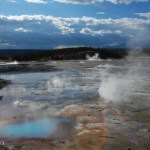yellowstone
By Joe Schwarcz PhD, Author, USASEF Expo Performer, AT&T Sponsored Nifty Fifty Program Speaker
Yellowstone National Park's iconic "Old Faithful" geyser is pretty faithful. It can be counted on to erupt every 50-90 minutes. Iceland's "Great Geysir," from which all other geysers get their name is less reliable. It was mostly dormant for sixty five years before it began semi-regular eruptions again in 2000 thanks to an earthquake. But in New Zealand, you can set your watch by the eruption of the Lady Knox Geyser, named after a former Governor of the country. At exactly 10:15 AM every…
Sorry about the lack of posts - I've been not only frantically prepping for class and my Eyja talk, but also I'm somewhat under the weather with an ill-timed sickness, so even though there is stuff to talk about, I haven't really had time/wherewithal to deal with it.
However, expect big things from Eruptions next week!
Drawing of a ship washed inland by the tsunami generated by the August 27, 1883 eruption of Krakatau.
I'll throw a few quick links:
The alert status at Galeras has been dropped back down to "orange" after the non-explosive eruption earlier this week. However, INGEOMINAS warns…
I am back from our trip into the Mountain West - and it was great (see some of the pictures below). We hit Yellowstone, the Grand Tetons, the Tobacco Root Mountains, Glacier and Craters of the Moon - and the weather held out on us just fine.
This week is the last week before classes start here at Denison, so post might be a little sparse this week ... and next week will bring something big to Eruptions, so stay tuned. I'll try to post some news soon as I get caught back up with what has been happening (including all the Katla talk). Special thanks again to Boris Behncke for the great Etna…
Park mangers say they euthanized "an aggressive, habituated, and human-food-conditioned black bear" Tuesday out of "concern for visitor safety."
But it was also a result of stupid people making unnatural food available to the bear.
The adult female bear had been seen frequenting the Slough Creek area in the park's north central area. The bear was 4 - 5 years old and weighed between 100 and 125 pounds. Some observers had mistaken her for a grizzly since it was brown in color.
In mid-July, the bear entered an occupied backcountry campsite in the Slough Creek drainage. Attempts to chase her away…
Kilauea lavas on the move near Kalapana. Image taken July 17, courtesy of the Hawaiian Volcano Observatory.
Some news over the last few days:
The lava flows from Kilauea are moving with a vengeance right now, damaging roads and heading for some structures. The lava flows near Kalapana have moved almost 200 meters since Sunday, closing within 100 yards of homes in the area. The lava is moving to the east along Highway 130 and 137 - and tourists are making it difficult to get around as they park to watch the lava - upwards of 2,000 people! A number of people (and dogs) have had to be…
A drop in the bucket - a massive pile of bison skulls about to be ground into fertilizer, photographed circa 1870. From Wikipedia.
From almost the very start, wolves were not welcome in Yellowstone. When the national park was established by the United States government in 1872 the bison population had crashed - a victim of westward expansion, the fur trade, and the desire to deprive native people of an animal important to their existence - leaving the area's wolves little recourse but to begin preying upon local livestock. This did nothing to help their reputation. Already seen as nature's…
A family of North American river otters (Lontra canadensis), photographed in Yellowstone National Park.
Yellowstone National Park is an amazing place. I stayed there for three days longer than I had originally planned and I still was not ready to leave it. Even if I had spent another week there I still would not have seen all the natural wonders of the park, but fortunately the BBC recently sent film crews to Yellowstone to capture its natural history in every season. These vignettes were expertly strung together in the miniseries Yellowstone: Battle for Life, and embedded below is one of the scenes in which a fox tries to catch dinner in the middle of winter:
see more Lolcats and funny…
News!
Toba caldera in Indonesia.
We're all still talking about the Chilean earthquake and the coverage of the event. If you happen to live in the Columbus area, you might have heard me on WTVN talking about the earthquake as well.
The Toba (Indonesia) eruption 74,000 years ago has been used by some researchers to be the cause of a "genetic bottleneck" for humans - however, that is still much debated. Currently, excavations are under away near Toba to look for evidence of human habitation that was buried by the eruption. The evidence of stone tools that appear to be made by the same human…
The Great Earthquake Swarm at Yellowstone that ushered in 2010 seems to be dying down, at least according to the USGS earthquake reports and analysis of the seismicity by the University of Utah and YVO. The daily updates on the earthquake swarms by Utah has ended. Looking at the earthquake over the last 7 days (see below), you can notice three things quickly: (1) since 2/6, there are much fewer quakes compared to a week and a half ago; (2) any sign the earthquakes were getting shallower seems to have ended; and (3) they seem to be generally smaller ( M1.5). Now, what does that mean? Like many…
News!
Pakistan is home to the world's tallest mud volcano in the region of Balochistan - and its somewhat near the reports of an "eruption" earlier this week.
Guess what? Since Wednesday evening, seismicity at Yellowstone has dropped precipitously. The last batch of earthquakes on February 3rd were also back to deeper levels - 8-9 km depth - compared to the potential shallowing earlier in the week. I'm sure the caldera will keep us on our toes, but as of now, it seems to have settled down a bit.
Over in Pakistan, there is mounting evidence that the recent "volcanic" eruption reported as, in…
With all the talk of the current Yellowstone earthquake swarm, I thought it would worth it to write a post on the the structure and caldera - and why we get earthquake swarms that are structurally rather than magmatically-related.
First off, lets think about why calderas formed. This is relatively simple - at least superficially. The land (or volcano) above a magmatic system is partially supported by that magma, especially because magma is hot and buoyant. The isostatic support by the magma holds up the land surface or volcanic edifice, so when an eruption expels a large volume of magma, this…
Steaming, gurgling mudpots in the active hydrothermal system of Yellowstone.
For those of you following Yellowstone (I think there might be a few of you), I've plotted up the earthquakes since 1/27 (see below) - and sure enough, although there is a lot of scatter, they are getting shallower - however what this exactly means is unclear. You can see my plots from 1/22-28 here. As many of you have mentioned, a caldera like Yellowstone is a big interconnected system, so a solely tectonic source of this is still possible as the displacement migrates through the fractured caldera rocks.
UPDATED…
First off, I wanted to thank all of the Eruptions readers for making January the most popular month ever on this blog. I suppose I should give an assist to Yellowstone, but really, thanks for coming to the blog, reading the posts and engaging in all the great discussions that go on within its (cyber)walls.
KÄ«lauea's east rift zone eruption site. Image courtesy of the USGS/HVO.
On to some news!
I suppose you've made the big time when you're in the New York Times, and sure enough, the current Yellowstone earthquake swarm is in the Old Grey Lady. Nothing much new to read, but summarizes the…
There has been a ... ahem ... healthy discussion of Yellowstone's current earthquake swarm on Eruptions as of late. We've now reached ~1,500 measurable earthquakes over the last 11 days. The latest reports of the continuation of the swarm isn't going to make anyone happy, but still, there are no signs that (a) this is out of the ordinary and (b) indicates magma making its way to the surface. In fact, if you plot the earthquakes since the 22nd of January, the depth appears to getting, well, deeper:
This plot shows the earthquakes listed on the USGS earthquake page since January 22 (oldest to…
Old Faithful geyser at Yellowstone National Park.
A few thoughts about faulting, earthquakes and eruptions:
The earthquakes at Yellowstone have been universally attributed to fault movement rather than magmatic activity by the USGS and the researchers at the University of Utah. This is likely based on the moment solutions for the earthquakes (i.e., the sense of motion on the earthquake - side to side, dilation, etc.) and the fact that there are no directly correlative volcanic/magmatic symptoms to go with them (such as pronounced, short-term bulging, excessive hydrothermal venting, etc.) Now…
Two quick notes:
A Costa Rican farmer evacuating in early January 2010 after renewed activity of Volcan Turrialba.
Well, it appears that after a quiet night on Friday, the current Yellowstone swarm picked up where it left off. We're now up to 1,200 earthquakes since January 17th, with a pair over M3 today. Of course, people are still uppity about the swarm, especially after the earthquake in Haiti, but really, they're about as connected as worrying about the rainy day in Boston when there was a typhoon in Malaysia. Just to get people on the same page, YVO still says: "The swarm events are…
Outcrops of Obsidian Butte, California, near the Salton Sea.
A brief update on the two earthquake swarms making news right now:
Yellowstone
The earthquake swarm at Yellowstone is still rumbling along, reaching over 1,000 earthquakes measured over the last week. However, the swarm has begun to die down overnight - with no earthquakes between 10:41 PM (MST) on 1/22 and 6 AM on 1/23. However, although this is a longer, bigger swarm than normal, it still isn't out of the regular rumblings at Yellowstone caldera. The USGS continues to say this swarm is tectonic, rather than magmatic or…
Quick news updates for a Wednesday...
The island (and volcano) of Gran Canaria in the Atlantic Ocean. It last erupted in ~20 B.C.
The earthquakes keep coming at Yellowstone - up to a M3.5 in the last 24 hours. Time has already put up an article wondering about whether people need worry about the swarm (there might be other things to worry about before this swarm). YVO's statement on the earthquake swarm seems pretty standard (as it should be): "At this time the Yellowstone Volcano Observatory does not consider the swarm to be unusual and the earthquakes are likely related to tectonic fault…
A hot spring in Yellowstone National Park. Image courtesy of the USGS.
Yesterday I left a little teaser about the current earthquake swarm going on at the Yellowstone Caldera. Eruptions readers have come through with even more information on the swarm. Over 250 earthquakes have occurred in the park over the last few days, most between 0.5-3.1 on the Richter Scale - and getting larger each day. The swarm is centered 10 miles northwest of Old Faithful, Wyoming and 9 miles southeast of West Yellowstone. However, before everyone gets too excited, Dr. Robert Smith of University of Utah (the go-to…



